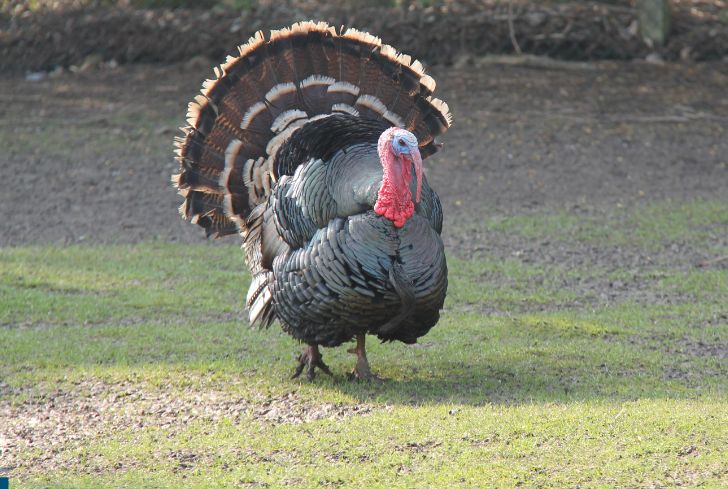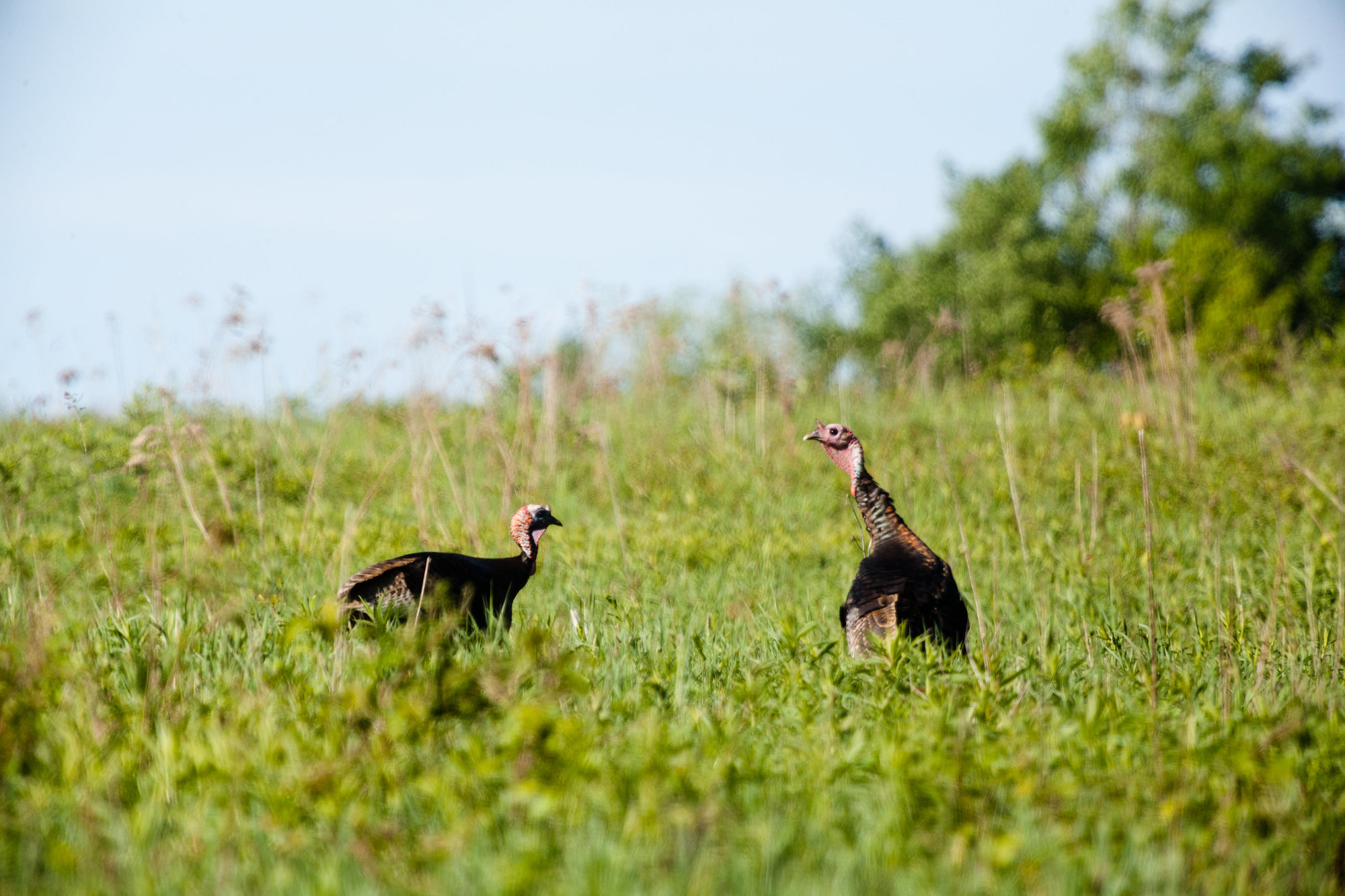Wild turkeys have incredible eyesight. Their ability to sense a predator, like a hunter leaning back against a tree, is uncanny. Turkey vision can seem even supernatural at times. But really, it’s just a combination of evolution and physiology. There’s still plenty we don’t know about how turkeys see, but researchers have uncovered plenty of interesting facts, many of which can be useful to hunters.
We know that a turkey’s vision is three times sharper than our own. They can also see nearly eight times farther than we can, and their color vision is far more enhanced than ours. Turkey vision has evolved over the course of millions of years to help them spot predators, locate mates, and identify challengers. Understanding how turkeys see and perceive danger just might help improve your hunting setups this spring.
Turkeys are known for their incredibly sharp vision, which allows them to spot threats from seemingly impossible distances. But just how far can a turkey actually see? As turkey hunters can attest, their eyesight appears almost supernatural at times. However, research has uncovered some fascinating facts about the visual abilities of these wary birds.
Turkey Vision Capabilities
-
270-degree field of vision – Turkeys have monocular vision, meaning their eyes work independently This gives them a 270-degree field of vision when their head is still By constantly moving their head, they achieve 360 degrees.
-
See in all directions – Turkeys can see in front above behind, and to the sides without turning their head. Their vision combined with hearing allows them to pinpoint threats.
-
Lack depth perception – Because their eyes are on the sides of their heads, turkeys lack clear depth perception. Their head bobbing helps compensate.
-
Enhanced color vision – Turkeys see a wider spectrum of colors than humans due to their retina having 7 types of photoreceptors compared to humans’ 4. This helps them spot camouflaged predators.
-
Third eyelid – Turkeys have a translucent third eyelid called a nictitating membrane that cleans their eyes every second. It works like a self-cleaning optic.
-
Poor night vision – Unlike some predators, a turkey’s night vision is very poor. They roost in trees at night and wait until full light to fly down.
-
Motion sensitive – While turkeys can’t see well in low light, they are extremely sensitive to motion during the day. Even slight movements at long distance can alarm them.
Estimating Turkey Vision Range
Many sources estimate that a wild turkey’s vision is anywhere from 3 to 10 times sharper than a human’s. But quantifying their maximum visible range is difficult. Here are some general observations:
-
Turkeys typically spot hunters first, even at several hundred yards, implying their vision range exceeds a human’s.
-
Turkeys alarmed by hunters 50-70 yards away in open fields suggest they see moderate movement at that distance.
-
Experts recommend assuming a turkey can see you if you can see the turkey without binoculars. Their vision is likely 6-10 times sharper.
-
Reports of turkeys busting hunters at 200+ yards while the hunter could only see the birds with binoculars indicate a long vision range.
-
Turkeys roosting in trees may have up to 50 times the vision range compared to when on the ground.
Overall, given their visual acuity and sensitivity to movement, mature turkeys likely have a maximum vision range of 500 yards or more under ideal conditions. However, this depends heavily on terrain, cover, and light conditions. It’s safe to assume that if a hunter is visible to a turkey, the turkey can see the hunter. Camouflage, minimal movement, and hiding your silhouette are key to avoid detection.
Turkey Vision and Hunting Strategy
Understanding the superb eyesight of turkeys can help hunters be more successful:
-
Use camouflage, facemasks, and blinds to blend into the surroundings. Avoid exposing skin.
-
Scout roost areas and setup before fly-down time in cover they can’t see through.
-
Avoid moving when calling and when turkeys are approaching. Their vision will detect it.
-
Don’t crown your silhouette against the sky on ridges or behind sparse cover.
-
Use a buddy as a spotter to avoid getting busted from an angle you can’t see.
-
Assume the turkey will see you if you move at all when it’s in sight. Stay still!
While turkeys have incredible vision, hunters can still beat them through woodsmanship, camouflage, and patience. Their eyesight has its limits when faced with an unmoving, concealed adversary. Understanding how far turkeys can see gives hunters an edge in the eternal battle of wits.

Turkeys Can See Color–Better Than Us
Of all the vertebrate species on the planet today, birds have the most complex retinas. Accordingly, they perceive a larger and richer spectrum of colors than humans and other mammals do.
Without getting too deep into eyeball science, the human retina has four types of photoreceptors, consisting of one rod and three single cones. Rods help us see in low light, while cones help convert light into color signals, allowing us to see short, moderate, and long wavelengths of blue, green, and red.
A turkey’s retina, on the other hand, has seven different types of photoreceptors: one rod, four single cones, and two double cones. This allows turkeys (and other birds) to see a spectrum of colors that are imperceptible to the naked human eye.
Dr. Chamberlain tells Outdoor Life that there’s some debate among the scientific community about whether or not turkeys can see in the UV spectrum. Regardless, he says, their color vision is “extremely acute.” This gives the birds another advantage when scanning their surroundings for predators.
“They can just pinpoint colors so well,” Chamberlain says. “Blues, blacks, and other things in their environment that may not look natural, they can pick these out immediately.”
The importance of color goes beyond predator detection, however. Hen turkeys use their enhanced color vision to seek out mates, as the fitter, more dominant toms are always more colorful than the others.
A strutting tom makes his presence known. Adobe stock
“If you’re a dominant male, you’re going to breed more than a subordinate tom,” Chamberlain explains. “They’re more fit and more aggressive. They have longer snoods, more colorful heads, and more iridescence [in their feathers].”
Turkeys also have the amazing ability to change their head color to communicate and express emotions, like when a strutting gobbler’s head transitions from bluish-white to a bright reddish color.
Turkeys Can See in All Directions at Once
When it comes to keeping an eye out for predators, a wild turkey’s greatest asset is its ability to see in all directions at once. Turkeys have monocular vision, which means their eyeballs function independently of one another. (As opposed to our own binocular vision that uses both eyes in concert.) This gives the birds a 270-degree field of vision when their heads are perfectly still. But as most turkey hunters know, this is rarely the case.
“If you pay attention, [turkeys] turn their heads constantly. And because their eyes are working independently, that offers them a 360-degree field of view,” says Dr. Mike Chamberlain, a Distinguished Professor at the University of Georgia who’s been researching wild turkeys for the past 30 years. “Whereas you and I have peripheral vision, but we can’t see above or behind us, turkeys can. By changing their head posture constantly, it allows their eyes to pick up movement as two independent periscopes.”

Chamberlain says turkeys also rely on their keen sense of hearing to augment their vision. Working in combination, these two senses allow them to quickly and accurately pinpoint potential predators and other turkeys.
“Their hearing is the same in the sense that each ear registers the sound independently and transmits it to their brain. Coupled with their vision, they can hear something, look in that direction, and they can pinpoint exactly where that sound is coming from,” he explains. “That’s why they have that uncanny ability [to locate other birds]. You call at them from the tree, and ten minutes later they’re standing right there at the tree.”
The biggest trade-off for being able to see in all directions at once is that turkeys don’t have clear depth perception. The classic turkey head bob helps with this shortcoming, according to The Wild Turkey: Biology and Management, a book that was published in 1992 by the National Wild Turkey Federation and edited by Dr. James G. Dickson.
“Though the three dimensions of space cannot be clearly perceived,” Dickson writes, “the turkey can determine relative distances by a slight turning of its head and viewing an object at different angles.”
